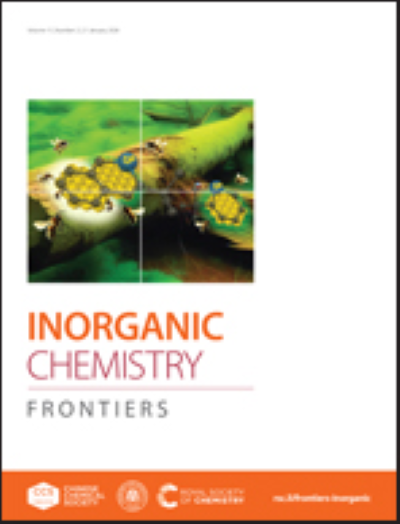Harnessing the Dual Role of DMSO in the Synthesis of SbOCl·DMSO: An Excellent UV Nonlinear Optical Crystal with Unique 1D Spiral Chain
IF 6.1
1区 化学
Q1 CHEMISTRY, INORGANIC & NUCLEAR
引用次数: 0
Abstract
Ultraviolet (UV) nonlinear optical (NLO) materials are essential for applications such as laser micromachining and optical parametric oscillations. An ideal UV NLO material should exhibit a large second-harmonic generation (SHG) coefficient, moderate birefringence and a short UV cut-off edge. However, achieving these properties simultaneously in a single material remains a significant challenge due to their distinct structural requirements. In this study, we report the synthesis of a novel UV NLO material, SbOCl·DMSO, which features an optimized 1D helical chain structure. For the first time, the polar organic molecule dimethyl sulfoxide (DMSO) is introduced into the SbCl3 system, where it coordinates with Sb atom via Sb-O bonds, modifying the chain structure. This unique 1D [SbOCl]∞ helical chain enhances the compound’s polarizability and optical anisotropy, leading to excellent optical properties. SbOCl·DMSO exhibits a large SHG coefficient of 4.4 × KDP, moderate birefringence of 0.084@546 nm and a short UV cut-off edge of 331 nm, making it a highly promising candidate for UV NLO applications. This work highlights the importance of synergistic molecular design and provides a new strategy for the development of high-performance frequency-doubling crystals.利用DMSO的双重作用合成SbOCl·DMSO:一种具有独特一维螺旋链的紫外非线性光学晶体
紫外非线性光学材料在激光微加工和光学参量振荡等应用中是必不可少的。理想的UV NLO材料应具有较大的二次谐波产生系数(SHG)、适度的双折射和较短的UV截止边。然而,由于其独特的结构要求,在单一材料中同时实现这些性能仍然是一个重大挑战。在这项研究中,我们报道了一种新型紫外NLO材料的合成,SbOCl·DMSO,具有优化的一维螺旋链结构。首次将极性有机分子二甲基亚砜(DMSO)引入到SbCl3体系中,通过Sb- o键与Sb原子配位,改变了SbCl3体系的链结构。这种独特的1D [SbOCl]∞螺旋链增强了化合物的极化率和光学各向异性,从而获得了优异的光学性能。SbOCl·DMSO具有4.4 × KDP的大SHG系数,0.084@546 nm的中等双折射和331 nm的短紫外截止边,使其成为极有前途的紫外NLO应用的候选材料。这项工作强调了协同分子设计的重要性,并为高性能倍频晶体的发展提供了新的策略。
本文章由计算机程序翻译,如有差异,请以英文原文为准。
求助全文
约1分钟内获得全文
求助全文
来源期刊

Inorganic Chemistry Frontiers
CHEMISTRY, INORGANIC & NUCLEAR-
CiteScore
10.40
自引率
7.10%
发文量
587
审稿时长
1.2 months
期刊介绍:
The international, high quality journal for interdisciplinary research between inorganic chemistry and related subjects
 求助内容:
求助内容: 应助结果提醒方式:
应助结果提醒方式:


